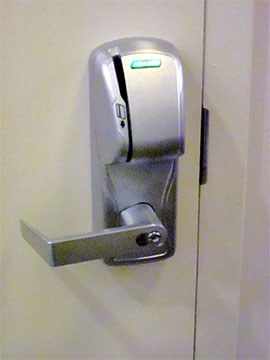Schlage Electronic Locks Help TCU Bolster Campus Security
Allegion, a provider of security products and solutions, today announced that Texas Christian University (TCU) partnered with Allegion to help enhance security for its students by installing Schlage electronic locks in new residence halls and upgrading access control in existing buildings. A major factor in deciding on the lock selection was its ability to interface with TCU’s existing student ID cards, which students use for meal plans, vending machines and other purposes.
With its expansion continuing and new residence halls under construction, TCU wanted an access control system that would provide security for its students, yet be compatible with its existing CBORD card system. Flexibility to upgrade and meet future needs was an important consideration. Appearance also played a role in the selection.
“We wanted the lock and reader to be an all in one unit and it had to be aesthetically pleasing,” said Supervisor, Building Maintenance Ver Barritt.
 To meet these needs, TCU selected Schlage AD-300 locks, hard-wired locks that are easy to install and provide online, real-time lock control. The integrated system makes it easy for administrators to add or remove users or to check the status of an opening. AD-Series locks combine all the components required at the door into one integrated design that incorporates the electrified lock, credential reader, request-to-exit switch, door position switch, tamper guard and more. Because the AD-Series is modular, it can be upgraded without taking the lock or the hardware off the door. This design allows institutions to minimize the cost of upgrading or adapting to technology as it changes. The AD-300 locks integrate seamlessly with the university’s CBORD CS access system to provide TCU with a cost-effective and scalable access control system.
To meet these needs, TCU selected Schlage AD-300 locks, hard-wired locks that are easy to install and provide online, real-time lock control. The integrated system makes it easy for administrators to add or remove users or to check the status of an opening. AD-Series locks combine all the components required at the door into one integrated design that incorporates the electrified lock, credential reader, request-to-exit switch, door position switch, tamper guard and more. Because the AD-Series is modular, it can be upgraded without taking the lock or the hardware off the door. This design allows institutions to minimize the cost of upgrading or adapting to technology as it changes. The AD-300 locks integrate seamlessly with the university’s CBORD CS access system to provide TCU with a cost-effective and scalable access control system.
The residence halls are configured with suites that incorporate several private rooms around a central area. The AD-300 locks are being installed on the entrance doors to each suite.
“If a student loses the key to his room, he is still secured in his suite by the card access and it saves us a lot of rekeying costs and emergency night calls,” said Barritt.
The changeable reader modules provide a unique advantage for TCU.
“If a student with disabilities has trouble sliding a card through the reader on his or her door, we can just change the module to one that also has push buttons,” explained Barritt.
More than 180 AD-Series electronic locks are deployed in two completed dormitories and also will be installed in a new residence hall now under construction. The AD-Series locks also will be used in future residence halls now being planned as well as for other applications throughout the campus. These include classrooms and offices in a new academic building and an addition to a nursing building.
“Eventually we would like to go to a keyless campus,” Barritt said.
Entrances to all buildings are secured by existing card readers and by Von Duprin 99 Series electrified exit devices. While access is controlled by the same cards as other applications, safe egress is provided by the exit devices. All exit devices feature the QEL (quiet electric latch). Since many of the entrances are located near residence suites, their quiet operation minimizes disturbance to sleeping or studying students.
Openings required to meet the ADA are equipped with LCN 4640 Auto Equalizer electrically powered low-energy operators. The college also uses Von Duprin keyed removable mullions, which make it easy to move large items in and out while providing greater physical security for double doors.